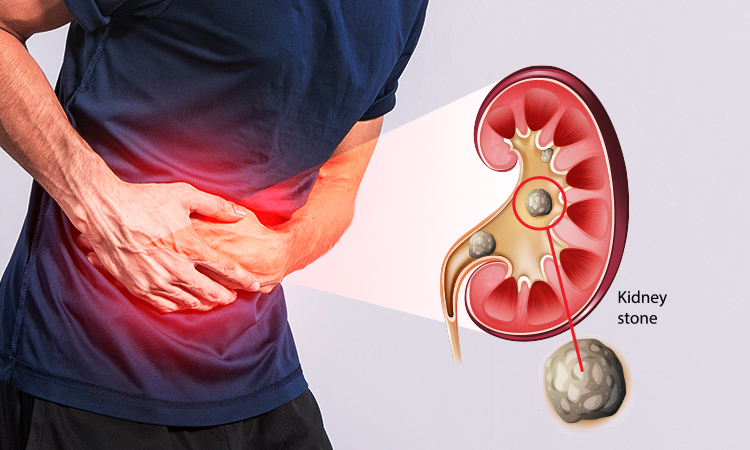How to Identify Kidney Stone Symptoms at an Early Stage
2025-10-10 / RG STONE HOSPITAL / Kidney Stone

That sudden sharp pain in your back. It comes out of nowhere. You do not know what it is. This could be one of the first kidney stone symptoms. Knowing these signs early can help you get treatment faster.
A kidney stone is a hard deposit. It forms inside your kidneys. It can be very painful when it starts to move. This guide will explain the common symptoms of kidney stone. It will help you understand what your body is telling you. Do not ignore these early kidney stone symptoms.
The First and Most Common Kidney Stone Symptoms
When a kidney stone moves it can cause a lot of problems. The signs can be intense. Here are the main kidney stone symptoms to watch for.
The Pain Is a Major Clue
The most famous of all kidney stone symptoms is the pain. It is not a dull ache. It is often a sharp cramping pain.
-
Location: You might feel it in your back. Or on your side just below your ribs. The pain can also move down to your lower abdomen and groin.
-
Feeling: The pain often comes in waves. It can be very intense for a few minutes. Then it might ease up. Then it comes back. This is because the stone is moving.
-
Severity: Many people say the pain from kidney stones is one of the worst pains they have ever felt.
Changes When You Urinate
Your urine can give you a lot of clues. Pay attention to what you see and feel. Changes here are very common symptoms of kidney stone.
-
Painful Urination: You might feel a sharp or burning pain when you urinate.
-
Cloudy or Bad-Smelling Urine: A kidney stone can cause an infection. This can make your urine look cloudy or smell strong.
-
Blood in the Urine: This is a key sign. Your urine might look pink red or brown. This is one of the most alarming kidney stone symptoms.
Other Important Signs
The pain and urine changes are the most direct signs. But your body might show other symptoms of kidney stone too.
-
Urgent Need to Go: You might feel like you constantly need to urinate. Even if you just went.
-
Urinating in Small Amounts: Even with the urgency you might only pass a little bit of urine at a time.
-
Nausea and Vomiting: Intense pain can often make you feel sick to your stomach.
-
Fever and Chills: If you have a fever with the pain it could mean you have an infection. This is serious.
Who Is Most at Risk for Kidney Stones?
Some people are more likely to get kidney stones. Understanding the risk factors can help you.
-
Age and Gender: Men between 40 and 60 are at high risk. But rates in women are rising fast especially between ages 20 and 50.
-
Dehydration: Not drinking enough water is the biggest risk factor. This is a big problem in hot climates like many parts of India.
-
Diet: Diets high in animal protein salt and sugar can increase your risk.
-
Weight: Being overweight is a major risk factor.
-
Medical History: If you have had a kidney stone before you are more likely to get another. A family history also increases your risk. Other conditions like diabetes and chronic UTIs are also linked to stones.
When to See a Doctor Immediately
You should not ignore these symptoms. If you experience any of the following you need to see a doctor right away. These are serious kidney stone symptoms.
-
Severe pain so bad you cannot find a comfortable position.
-
Pain that is combined with nausea and vomiting.
-
Pain that is accompanied by a fever and chills.
-
Blood in your urine.
-
Difficulty passing urine at all.
When you have these symptoms of kidney stones you need a clear diagnosis. You need a specialist. A hospital like RG Hospital uses advanced imaging like CT scans and ultrasounds to get a clear picture of the problem. They can see the stone's size, its type and its exact location. This is how they decide the best way to help you.
What Happens After a Diagnosis?
Once a doctor confirms you have a kidney stone the treatment will depend on the stone itself.
Many small stones can be passed at home. Your doctor might tell you to drink a lot of water. And take pain medicine. This can help flush the stone out of your system.
But some stones are too big. Or they cause too much pain. Or they are blocking the flow of urine. In these cases you need medical treatment to remove the stone.
For stones that are too big or painful to pass you need advanced treatment. A specialized center like RG Hospital offers modern minimally invasive options. Things like shockwave therapy (lithotripsy) and advanced laser surgery can break up stones without big cuts. This means less pain and a faster recovery for you. They have the expertise to handle even large and complex stones successfully.
Conclusion: Listen to Your Body's Warning Signs
Recognizing early kidney stone symptoms is very important. The pain and other signs are your body's way of telling you that something is wrong. Do not try to just tough it out.
Getting a proper diagnosis and treatment is the best way to find relief and avoid more serious problems.
What is one lifestyle change you could make to lower your risk of kidney stones?
Categories
Hernia Repair
Appendicitis
Piles
Urological Treatment
Hernia treatment
Enlarged Prostate (BPH)
Gall Bladder Stone
Urinary / Kidney Stone
Vitamins
Indian Health Care System
Exercise
Obesity
Female Urinary Incontinence
Single Incision Laparoscopic Surgery (SILS)
Kidney Cancer
Bladder Cancer
Ovarian cancer
Nephrology
Bariatric Surgery
Kidney Function Test
Female Urology
Radiation Therapy
Alcoholic Fatty Liver
Liver disease
Gastroenterology
Kidney Disease

